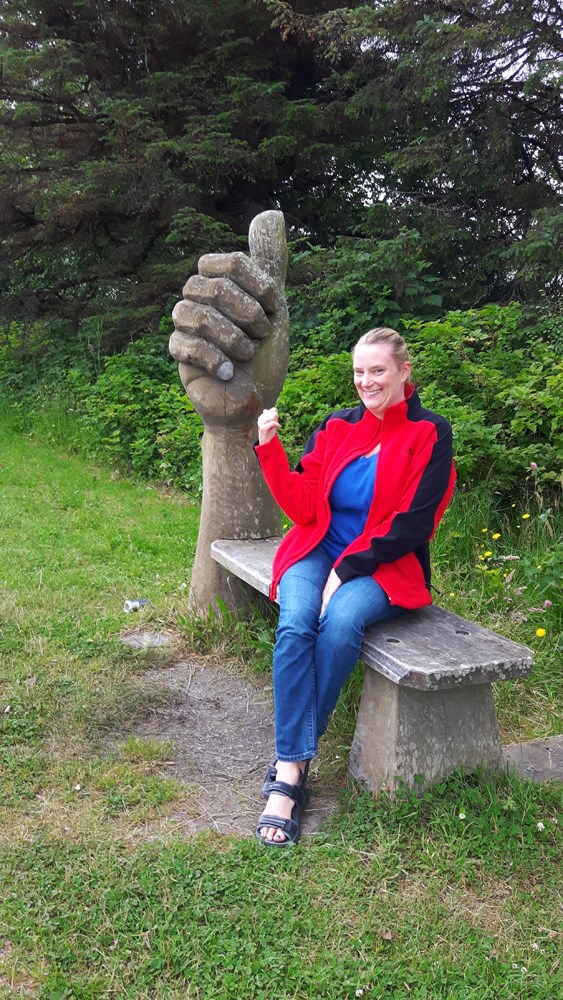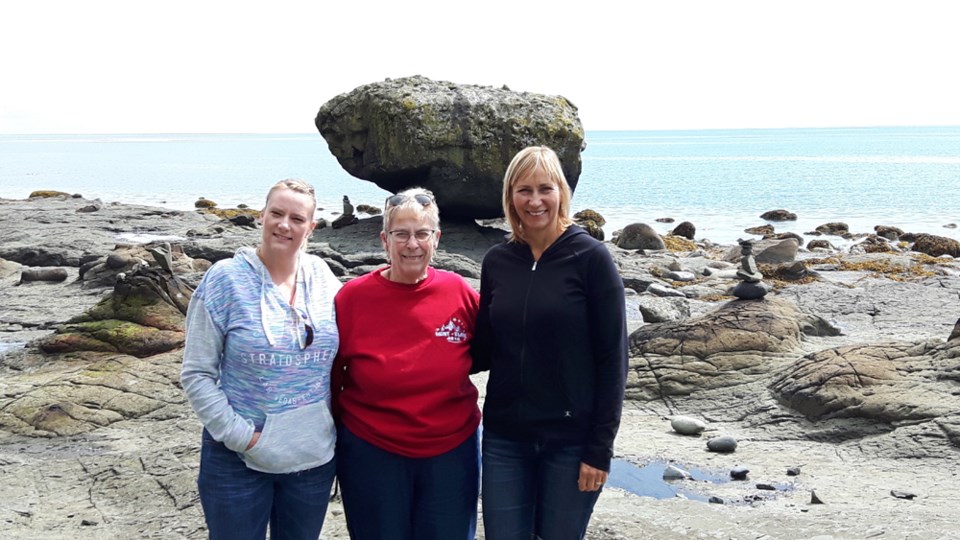Squamish's Kimberley Anne Parsons' obituary shows her atop a horse, with mountains in the background and a huge grin on the then 48-year-old's face.
Parsons died Feb. 7, with stage 4 pancreatic cancer.
While tragic, her death was also an example of how Parsons chose to live and die on her own terms.
She chose a medically assisted death, something she wrote about beforehand, in her own obituary.
The Parliament of Canada passed federal legislation in June 2016 that allows eligible Canadian adults to request medical assistance in dying.
Kim’s mom, Carol Parsons, and her sister Terry Pratt shared with The Chief memories of Kim, her life, and the way she chose to die.
What follows is an edited version of that conversation.
Q: What was Kim like as a child? What were her passions as an adult?
Carol Parsons: As a child, Kim was very determined. She'd decide she was going to do something and then go ahead and do it no matter what. The same if she didn't want to do something — pretty hard to convince her otherwise. In Grade 8, she was taking typing when she discovered she'd have to cut her fingernails. She quit typing instead, despite everybody telling her typing was more important.
She did love hair, makeup and her nails (sometimes she was a bit avant-garde causing much parental discussion) so she became a hair stylist and did that until just before she died.
She was always very loyal to her friends and always willing to help anybody who needed it. Everybody knew she loved animals, so they'd bring her strays and needy animals all the time. Once, the old Loggers Inn phoned to tell her that there was a kitten crying under their building so she went down, crawled under the building, retrieved the kitten and found it a home. She was in Grade 7 or 8 at that time.

Terry Pratt: Kim was bigger than life. She had this spirit that everyone was attracted to when she was in the room. She was very funny and quick-witted. She looked at things with a wicked sense of humour that kept us laughing, even through her illness and dying process. When she was diagnosed, she did a weekly blog for the family called ‘Dying with Laughter,' talking about her experiences of living in a small town going through this process.
When she was first diagnosed and had only weeks to live, she also wanted to go horseback riding one more time so her good friends arranged for it almost the first week after her diagnosis. She texted me the beautiful photo we used in the obituary with her on a horse and the snowy Rocky Mountains in the background, and her only comment was: “Check."
Kim loved animals. Some of our favourite memories as a family are spending time with her in Squamish on her little farm, with her big lovable dogs, the goats, the chickens and the peacocks she got from the neighbours. She only had them for one day because they walked a kilometre along Upper Squamish Road back to their original farm because they missed their flock. Lots of laughs about that one, imagining what it must have looked like to folks driving home and seeing the peacocks walking home.

Q: Can you tell me about the process in deciding that she wanted an assisted death? I imagine this took a long time to decide?
Terry Pratt: No, it did not take any time for her to decide that was what she wanted. She did not want to be a burden to her family and friends and was not afraid of dying. She had a strong belief in the eternal nature of spirit and was looking forward to her next adventure. Her comment to us was that the dying part was easy, it was the leaving that was hard. She told us that her last days would be about what we needed in terms of saying goodbye and not what she needed. She was the strongest, most courageous person I know. Her strength and determination through this whole process were incredible.
Q: Why did she want an assisted death?
Carol Parsons: She was very ill and had been told she had only two months to live. She was never afraid of dying and was very curious about what happens next. She saw no point in suffering any more as there was nothing she could do to change that. She was a very pragmatic person. She made sure that all the family had a chance to come and see her and then she set the date for as soon as they'd all been. She actually arranged everything herself up to writing her own obituary.
Terry Pratt: She didn’t want to be a burden to her family and she also didn’t want to endure the pain of her illness any longer than she had to. Before the legislation came into force, we often talked as a family about how society is more humane to our pets than we are to people, in terms of being able to put them out of their pain. Kim’s one fear was that the illness would progress so fast that she wouldn’t be of sound mind to make the decision at the time. One of the criteria for the legislation is that on the day, the person must be able to communicate to the attending physician that they would like him or her to proceed with the medically-assisted dying process. When you are critically ill, things can progress very quickly and the patient may not be able to communicate with their doctor to confirm they wish to proceed. This was Kim’s biggest fear.
Q: How was this process for her family?
Carol Parsons: It was a very calm and peaceful and gentle way to move on. Easier on her and easier on the family.
Terry Pratt: It was what it was. We are all strong supporters of the medical assistance in dying legislation and fully respected Kim’s decision. We only had a month with her once the diagnosis was confirmed, but we spent some wonderful time with her.
Q: Anything you can/want to tell me about her last day?
Terry Pratt: It was beautiful. Very calm, very compassionate. The medical team was wonderful. We are so grateful that there are doctors and nurses willing to do this, as many choose not to.
Q: What do you want others to know about Medical assistance in dying (MAID)?
Terry Pratt: We understand from Kim that doctors are not legally able to present medically induced dying as an option as part of the palliative care process. Patients must request it directly so that’s important to know. The terminally ill person must have a prognosis of eight weeks or less to live, confirmed by two doctors before the procedure can be done. The patient must be of sound mind and able to communicate, in some manner, to the attending doctor that they are ready for the procedure.
This Act was a godsend to our family. We didn’t want to see Kim suffer from the awfulness of stage 4 pancreatic cancer any longer than she had to, and neither did Kim. We know the concept of medically assisted induced dying is a complex question for many people, which is why it has taken so long for it to be enacted.
Our family is incredibly grateful it was an option for Kim, which is why we are happy to talk to you about it. It’s important that people know about medically-induced dying and can decide for themselves if it is something they want to consider.
Q: How are you all doing now?
Terry Pratt: We are doing OK. It’s still fresh so there are some days where something will bring back memories but we know Kim is out of pain and in a better place.
For more on medical assisted dying, go to www.canada.ca/en/health-canada/services/medical-assistance-dying.html



